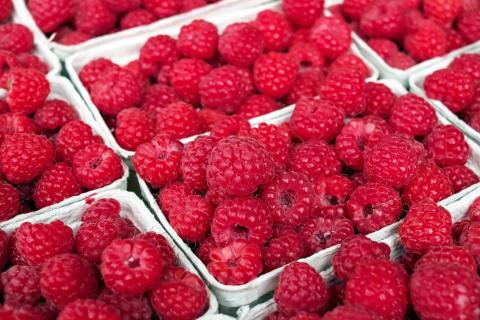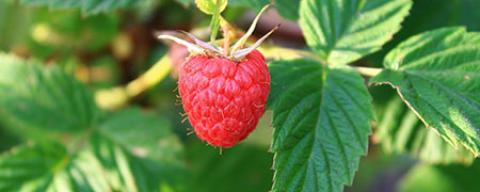Top Ten Tips for Successful Backyard Raspberry Production
Follow these tips to grow delicious raspberries in New Hampshire
SHARE
- Site Selection: Raspberries thrive with good airflow, ample sunlight and well-draining soil rich in organic matter. Avoid planting where solanaceous crops (like tomatoes and potatoes) have grown in the past four years to prevent Verticillium wilt. Clear wild brambles within 600 feet to minimize virus and pest risks.
- Watering: These shallow-rooted plants need consistent moisture, ideally 1-2 inches per week. Ensure good drainage though to avoid “wet feet.” If natural rainfall isn’t enough, consider drip irrigation for even watering.
- Mulch: Mulching helps retain moisture and suppress weeds within the row, but can also delay fruit ripening, interfere with fall plant hardening and harbor rodents. Avoid mulching on heavy soils after the first year to prevent Phytophthora root rot.
- Variety Selection: Choose between summer-bearing or everbearing (fall-bearing) raspberries, available in red, black, purple and yellow. Specific management regarding pruning, harvesting times and yield will depend on the raspberry type. Select cultivars best suited to your plant hardiness zone.
- Trellising: Train all raspberries on a trellis to keep canes off the ground. Red and yellow raspberries form hedges and can use a simple “T” trellis, while black and purple varieties can benefit from staking and tying canes to individual posts.
- Pruning: Essential for airflow, light penetration and fruit production. Summer-bearing cultivars (floricane-bearing) need pruning after fruiting and in early spring, leaving 4-6 strong canes per foot in a 12-18 inch wide row. Everbearing cultivars (primocane-bearing) are pruned to the ground in early spring and thinned in summer. Black and purple raspberries require similar pruning to summer-bearing reds, but also includes tipping to encourage lateral branching.
- Weed Control: Weeds compete for water and nutrients and can harbor pests and diseases. Avoid planting in areas with persistent perennial weeds, remove weeds within rows and consider cover crops or permanent sod between rows.
- Pest and Disease Prevention: Follow best practices for planting, pruning, sanitation and harvesting. Plant virus-free stock, ensure good plant spacing and soil drainage, remove diseased canes and fallen fruit/leaves and prune annually.
- Wildlife Protection: Fencing and netting can be used for keeping various wildlife away.
- Harvest and Enjoy: Pick fruit when it is firm and easily comes off the receptacle or core. Refrigerate immediately and wash off when ready to eat!
Suggested Resources

Growing Fruit: Raspberry and Blackberry Varieties for New Hampshire [fact sheet]
This resource was developed to help New Hampshire growers select among the many raspberry and blackberry varieties available. Growers in Northern areas should prioritize winter hardiness.

Growing Fruits: Raspberries and Other Bramble Crops [fact sheet]
Raspberries can be an enjoyable crop for the conscientious gardener. A well-maintained raspberry bed can provide fruit for 10 to 20 years. Red raspberries grow well throughout New England. This fact sheet discusses all brambles, but focuses on specifically on raspberry.
Do you love learning about stuff like this?
SUBSCRIBE TO Granite State Gardening newsletter
Got questions? The UNH Extension Yard and Garden Infoline offers practical help finding answers for your yard and garden questions.
Call toll free at 1-877-398-4769, Monday to Friday, 9 a.m. to 2 p.m., or fill out webform.
Author(s)
Categories
